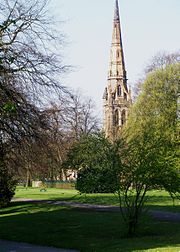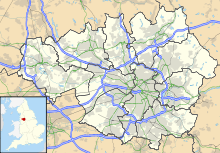- Holy Trinity Platt Church
-
Holy Trinity Platt Church Holy Trinity Church, Rusholme
Spire of Holy Trinity Platt ChurchLocation in Greater Manchester Coordinates: 53°27′00″N 2°13′32″W / 53.4501°N 2.2255°W OS grid reference SJ 851 948 Location Platt Lane, Rusholme, Manchester Country England Denomination Anglican Churchmanship Evangelical Website Holy Trinity Platt History Dedication Holy Trinity Consecrated 26 June 1846 Architecture Status Parish church Functional status Active Heritage designation Grade II* Designated 18 December 1963 Architect(s) Edmund Sharpe Architectural type Church Style Gothic Revival Groundbreaking 1845 Completed 1912 Specifications Materials Terracotta, slate roof Administration Parish Holy Trinity at Rusholme Deanery Hulme Archdeaconry Manchester Diocese Manchester Province York Clergy Vicar(s) Rev Steve James Laity Reader Peter Capon, David Poole
Isabel TurleyChurchwarden(s) Rob Turley
Richard LanderHoly Trinity Platt Church (also known as Holy Trinity Church, Rusholme), is in Platt Lane, Rusholme, Manchester, England. It is an active Anglican parish church in the deanery of Hulme, the archdeaconry of Manchester, and the diocese of Manchester.[1] The church has been designated by English Heritage as a Grade II* listed building.[2] It is the second "pot church" designed by Edmund Sharpe, so-called because the main building material used in the construction of the church is terracotta.[3]
Contents
History
The church was built in 1845–46 to a design by the Lancaster architect Edmund Sharpe. It was built for Thomas Carrill Worsley of Platt Hall. The Worsley family chapel had been Platt Chapel, but this had become a Unitarian chapel early in the 19th century. Thomas Worsley planned to build an Anglican church, but in this he was in competition with a neighbour, a Mr Anson of Birch Hall, to build the first Anglican church in the area. Anson built St James' Church in Danes Road, Rusholme, but Worsley arranged for Holy Trinity to be consecrated before its building was complete. Worsley chose the dedication to the Holy Trinity to show his opposition to the Unitarians.[3]
Sharpe's first "pot church" had been St Stephen and All Martyrs' Church, Lever Bridge. The terracotta for the body of this church was supplied, as before, by the Ladyshore Coal and TerraCotta Company, which was owned by Sharpe's brother-in-law, John Fletcher. However there was a dispute with Fletcher about the costs; Fletcher supplied the terracotta for the body of the church, but the material for the spire was provided by a different manufacturer, Fletcher's brother-in-law, Edmund Peel Willock.[3][4] The church was consecrated on 26 June 1846 by Rt Revd John Bird Sumner, Bishop of Chester, although the spire was not completed until 1850.[4] The terracotta for the spire proved to be inferior to Fletcher's material, and the spire had to be replaced in 1912. In 1966–67 a church hall was built and attached to the east wall of the church.[3]
Architecture
Exterior
Terracotta is used as the facing material for both the interior and the exterior of the church.[3] It is made to imitate stone, even to the use of masons' marks. The roof is in slate. The architectural style of the church is Decorated.[2] Its plan consists of a five-bay nave with a clerestory, a southwest steeple, north and south aisles, a two-bay chancel, a west porch, and a south porch contained in the tower.[2][3] The tower is in three stages with angle buttresses and it has a south doorway. Its middle stage contains three-light windows with crocketted gables, above which are paired bell openings. The summit of the tower has an embattled parapet and corner pinnacles. On the tower is a tall octagonal spire supported by flying buttresses. The west window of the church has four lights, and the east window has five lights containing elaborate tracery.[2]
Interior
Internally, terracotta is used even for the piers of the arcades. The font is in stone and has an octagonal bowl. The stained glass in the chancel forms a memorial to the Worsley family and dates from 1849–50. In the north aisle is a window dated 1871 with glass made by Lavers, Barraud and Westlake.[3]
See also
- List of architectural works by Edmund Sharpe
- Grade II* listed buildings in Greater Manchester
References
- ^ Holy Trinity Platt, Manchester, Church of England, http://www.achurchnearyou.com/venue-19697/, retrieved 18 June 2010
- ^ a b c d "Church of Holy Trinity, Platt Lane, Manchester", The National Heritage List for England (English Heritage), 2011, http://list.english-heritage.org.uk/resultsingle.aspx?uid=1246948, retrieved 16 May 2011
- ^ a b c d e f g Hartwell, Clare; Hyde, Matthew; Pevsner, Nikolaus (2004), Lancashire: Manchester and the South-East, The Buildings of England, New Haven and London: Yale University Press, pp. 466–468, ISBN 0-300-10583-5
- ^ a b Hughes, John M. (2010), Edmund Sharpe: Man of Lancaster, John M. Hughes, pp. 258–270
Categories:- Grade II* listed churches
- Church of England churches in Greater Manchester
- Grade II* listed buildings in Greater Manchester
- Gothic Revival architecture in England
- Religious buildings completed in 1846
- 19th-century church buildings
- Religious buildings completed in 1912
- Anglican Diocese of Manchester
- Edmund Sharpe buildings
- Terracotta
Wikimedia Foundation. 2010.


